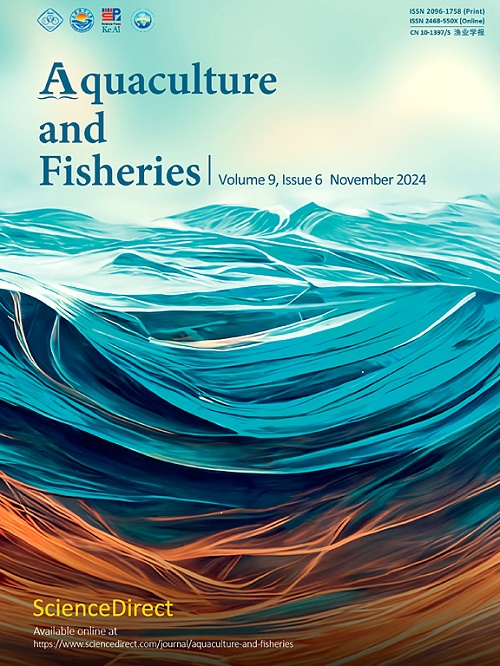组织蛋白酶b的多态性与亚洲鲈鱼的生长有关
Q1 Agricultural and Biological Sciences
引用次数: 0
摘要
本研究探讨了亚洲海鲈组织蛋白酶B (ctsb)基因多态性与体重的关系。尽管这一物种具有重要的经济意义,但影响鱼类生长性能的遗传因素仍然知之甚少。CTSB是一种参与蛋白质降解和组织重塑的溶酶体半胱氨酸蛋白酶,是一种重要的生长调节剂。我们分析了ctsb的全长cDNA,并将其定位到钙化L.连锁群2上生长的主要数量性状位点(QTL)。在298例个体中鉴定了ctsb内的单核苷酸多态性(snp),并分析了其与体重的关系。结果显示,ctsb内含子2中的SNP1 (C >; T)与体重显著相关。实时荧光定量PCR (Quantitative real-time PCR, qRT-PCR)结果显示,ctsb在发育中的鲈鱼各组织中均有表达,其中鳃和肾表达量最高。ctsb在细胞系中敲低/过表达分别促进/抑制细胞增殖,但不改变细胞大小。这些结果表明,ctsb在亚洲鲈鱼的生长调节中起着重要作用。该研究为快速生长的亚洲海鱼的筛选提供了潜在的分子标记。未来的研究应侧重于识别与ctsb加速生长相关的因果变异,进行体内研究,并探索相关的信号通路。本文章由计算机程序翻译,如有差异,请以英文原文为准。
Polymorphisms in cathepsin b is associated with growth in Asian seabass
This study investigates the relationship between polymorphisms in the cathepsin B (ctsb) gene and body weight in Asian seabass (Lates calcarifer). Despite the economic significance of this species, the genetic factors that influence growth performance in fish remain poorly understood. CTSB, a lysosomal cysteine protease involved in protein degradation and tissue remodelling, is a crucial regulator of growth. We analysed the full-length cDNA of ctsb and mapped it to the major quantitative trait locus (QTL) for growth on linkage group 2 in L. calcarifer. Single nucleotide polymorphisms (SNPs) within ctsb were identified and their associations with body weight were analysed in 298 individuals. Results revealed that SNP1 (C > T) in intron 2 of ctsb was significantly correlated with body weight. Quantitative real-time PCR (qRT-PCR) showed that ctsb was expressed in all tissues, with the highest expression in the gills and kidney of developing seabass. Knockdown/overexpression of ctsb in cell lines respectively promoted/inhibited cell proliferation without altering cell size. These findings suggest that ctsb plays a significant role in growth regulation in Asian seabass. This study provides a potential molecular marker for selecting fast-growing Asian seabass. Future research should focus on identifying causal variants in ctsb associated with accelerated growth, conducting in vivo studies, and exploring related signalling pathways.
求助全文
通过发布文献求助,成功后即可免费获取论文全文。
去求助
来源期刊

Aquaculture and Fisheries
Agricultural and Biological Sciences-Aquatic Science
CiteScore
7.50
自引率
0.00%
发文量
54
审稿时长
48 days
期刊介绍:
 求助内容:
求助内容: 应助结果提醒方式:
应助结果提醒方式:


